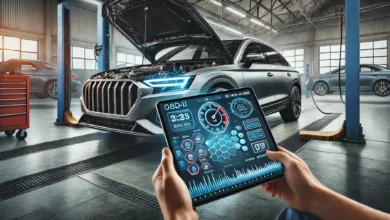Exploring the Power of Edge Computing for Faster Data Processing
Introduction
In a world where speed and efficiency have become critical metrics for success, edge computing has emerged as a transformative technology. But what exactly is edge computing? Simply put, edge computing is the practice of processing data closer to where it is generated, rather than relying solely on centralized data centers or cloud platforms. By minimizing the distance that data must travel, edge computing helps to reduce latency, improve real-time data processing, and significantly enhance performance.
In today’s digital landscape, the volume of data being produced is astronomical. From smart devices to industrial sensors, data is being generated at an unprecedented pace. Centralized cloud solutions, while powerful, can sometimes struggle to keep up with the demands of real-time processing due to inherent latency and bandwidth issues. This is where edge computing steps in, offering faster, more efficient data processing by decentralizing computation and bringing it closer to the source.
Let’s dive deeper into the world of edge computing and explore how it can revolutionize the way data is processed.
The Evolution of Data Processing
The journey of data processing has come a long way. Historically, data was processed in large, centralized data centers, often located miles away from the end user. As the internet grew, cloud computing became the preferred solution, allowing data to be stored and processed remotely. This enabled scalability, resource flexibility, and cost savings.
However, the rise of devices like smartphones, IoT sensors, and connected cars has introduced a new challenge. These devices require real-time processing, and the latency involved in sending data back and forth to the cloud can cause delays. Cloud computing, while powerful, struggles with this demand for immediacy, especially when data needs to be processed within milliseconds. This challenge gave rise to edge computing.
How Edge Computing Works
Edge computing works by shifting data processing away from centralized data centers and distributing it across edge devices, edge servers, or small data hubs located closer to the data source. This decentralization allows for faster processing and decision-making.
Imagine a self-driving car navigating traffic. It constantly collects data from its sensors and cameras to make decisions in real-time. If this car relied solely on cloud computing to process that data, there would be significant delays in decision-making, putting passengers at risk. By processing the data locally at the “edge,” the car can analyze information instantly and respond to road conditions without waiting for a round trip to the cloud.
Edge computing infrastructure typically consists of three main components:
- Edge Devices: These are the hardware devices (sensors, cameras, etc.) that generate data.
- Edge Nodes: These are the local servers or gateways that process data near the source.
- Cloud Integration: The cloud remains as a backbone, used for long-term storage and further analysis, but critical, time-sensitive tasks are handled at the edge.
Key Benefits of Edge Computing
Edge computing offers a wide range of advantages, making it a game-changer for various industries. Below are some of its most compelling benefits:
Speed and Latency Reduction
One of the most significant advantages of edge computing is the drastic reduction in latency. By processing data closer to the source, the time it takes to deliver results is cut down. This low-latency environment is essential for industries that require real-time responses, such as autonomous vehicles, healthcare, and gaming.
Enhanced Scalability
As more devices come online, especially with the advent of the Internet of Things (IoT), scaling data processing becomes a challenge. Edge computing helps by distributing workloads across multiple nodes, making it easier to manage vast networks of connected devices without overwhelming a single server or cloud environment.
Bandwidth Optimization
With data being processed locally, edge computing significantly reduces the amount of data that needs to be transmitted to central servers or the cloud. This reduces bandwidth usage and ensures that only the most essential data is sent to the cloud for further analysis or storage.
Improved Security and Privacy
By processing sensitive data locally, edge computing minimizes the risk of data breaches during transmission. Additionally, edge devices can implement localized security measures, ensuring that sensitive information never leaves the network unless absolutely necessary.
Real-Time Data Processing and Analytics
Industries like manufacturing, healthcare, and retail thrive on real-time data insights. Edge computing allows businesses to process and analyze data in real-time, making it possible to react quickly to changes, predict outcomes, and optimize operations.
Edge Computing vs. Cloud Computing
At this point, you might be wondering how edge computing stacks up against traditional cloud computing. Both have their strengths, but edge computing truly shines when real-time data processing is needed.
Comparative Analysis
Cloud computing is ideal for heavy computational tasks, storage, and large-scale data analysis. However, it struggles with latency and bandwidth when immediate processing is required. On the other hand, edge computing excels in scenarios where milliseconds matter, making it perfect for real-time applications such as IoT devices, autonomous systems, and AI-driven processes.
When to Use Edge Over Cloud
While cloud computing is excellent for tasks like long-term storage and complex computations, edge computing is better suited for tasks requiring real-time data processing and low-latency environments. Industries that need instant decision-making, such as healthcare (with medical devices) or autonomous vehicles, are better served by edge computing.
The Hybrid Model
Many companies are now adopting a hybrid model, where both edge and cloud work together. Critical tasks are handled at the edge, while less time-sensitive processing, analysis, and storage are managed in the cloud. This approach offers the best of both worlds, combining speed with power and scalability.
Applications of Edge Computing in Different Industries
Edge computing has found applications in a wide variety of industries, transforming how businesses operate and deliver services.
Smart Cities
Edge computing is helping build smarter cities by powering systems like traffic management, public safety, and utilities. Real-time data from sensors and cameras can be processed locally to manage traffic flow, monitor public spaces, and optimize energy consumption.
Healthcare
From telemedicine to wearable health devices, edge computing is revolutionizing healthcare. By processing patient data locally, devices can deliver real-time insights into a patient’s health, enabling faster diagnoses and treatments.
Manufacturing and IoT
Edge computing is a critical component in the Industrial Internet of Things (IIoT). By processing data from sensors and machinery in real-time, manufacturers can detect anomalies, predict failures, and optimize production processes.
Autonomous Vehicles
As mentioned earlier, autonomous vehicles rely heavily on edge computing to make real-time decisions. Edge computing enables vehicles to process data from sensors and cameras locally, allowing them to respond instantly to road conditions.
Retail and E-commerce
In retail, edge computing can be used for real-time inventory tracking, personalized shopping experiences, and fraud detection, ensuring that customers receive a seamless and secure experience.
Edge Computing in IoT Ecosystems
The Internet of Things (IoT) thrives on fast data processing and seamless connectivity. Edge computing plays a pivotal role in ensuring IoT devices work efficiently by processing data locally, reducing the burden on central servers.
Data Localization and Minimization of Latency
IoT devices generate massive amounts of data. Sending all of that data to the cloud for processing would not only increase costs but also introduce latency. Edge computing helps localize data processing, ensuring that IoT systems run smoothly with minimal delays.
Edge Nodes and Sensors
In an IoT ecosystem, edge nodes act as intermediaries between devices and the cloud. These nodes collect data from sensors, process it, and then send relevant information to the cloud if needed. This reduces the load on cloud servers and ensures faster data processing.
The Role of 5G in Edge Computing
The advent of 5G technology has further accelerated the adoption of edge computing. With its promise of ultra-fast data speeds and low-latency communication, 5G is a perfect match for edge computing.
Ultra-Reliable Low-Latency Communication (URLLC)
5G offers ultra-reliable low-latency communication, which is essential for applications like autonomous vehicles, remote surgery, and augmented reality (AR). This capability enables edge computing to perform even better in environments where speed and reliability are paramount.
Expanding the Edge Network
With 5G, the edge network can be expanded to include more devices and locations, making it easier to distribute data processing across a wide range of edge nodes. This helps reduce congestion on central servers and ensures smoother data flows across networks.
Challenges in Implementing Edge Computing
While edge computing offers many advantages, it also presents certain challenges, particularly in terms of infrastructure and security.
Infrastructure Costs and Maintenance
Deploying edge computing infrastructure can be expensive, especially for businesses that need to scale quickly. Maintaining these edge nodes, especially in remote locations, can also be challenging.
Security Concerns
Though edge computing offers localized security, it also introduces new vulnerabilities. Managing security across multiple edge nodes can be complex, and ensuring that these nodes are protected against cyber threats requires robust security protocols.
Managing Data Distribution
With data being processed across multiple edge nodes, managing data distribution becomes a complex task. Ensuring that the right data is processed in the right place at the right time is crucial for maintaining efficiency.
Edge Computing and AI
Artificial Intelligence (AI) and edge computing are a powerful combination. Edge computing can enhance AI capabilities by enabling real-time data analysis and decision-making at the source.
Real-Time Decision Making
AI-powered edge computing can process data in real-time, making it possible for devices to make intelligent decisions instantly. This is particularly valuable in industries like healthcare, manufacturing, and autonomous vehicles, where quick decision-making is critical.
Use Cases of AI-Powered Edge Computing
Edge AI is already being used in facial recognition systems, predictive maintenance, and smart security cameras. These systems can analyze data locally, make decisions, and act without needing to send data to the cloud for processing.
Edge Computing for Faster Data Processing in Emerging Technologies
Edge computing is playing a key role in emerging technologies, enabling faster data processing and better user experiences.
Augmented and Virtual Reality (AR/VR)
AR and VR require immense computing power and low-latency data processing. Edge computing helps deliver these experiences in real-time, enabling smoother graphics and more responsive interactions.
Gaming
The gaming industry is another beneficiary of edge computing. With the rise of cloud gaming and VR gaming, edge computing helps minimize latency, ensuring players experience smooth and immersive gameplay.
Smart Homes and Buildings
Edge computing is at the heart of smart home technology, where devices like smart thermostats, cameras, and security systems need to process data locally for real-time functionality.
Scalability and Edge Computing
As more devices come online, scalability becomes a critical consideration for businesses. Edge computing offers a distributed architecture that makes scaling easier.
Distributed Computing Architecture
Instead of relying on a central server to handle all processing, edge computing distributes tasks across multiple nodes, making it easier to scale as the number of connected devices grows.
Micro Data Centers and Edge Nodes
Micro data centers and edge nodes provide localized processing power, making it possible to scale computing resources without overwhelming central data centers.
The Future of Edge Computing
Edge computing is still in its early stages, but its potential for transforming data processing is enormous.
Trends Shaping Edge Computing
Several trends are driving the growth of edge computing, including the rise of AI, IoT, and 5G. As these technologies evolve, the need for faster, more localized data processing will continue to grow.
Edge Computing and Quantum Processing
Quantum computing is expected to revolutionize data processing. While still in its infancy, the combination of edge computing and quantum processing could open up new possibilities for solving complex problems quickly.
What Lies Ahead
As edge computing continues to mature, it will likely become an integral part of how businesses and industries manage data. The rise of smart cities, autonomous systems, and connected devices will drive further adoption of edge technologies.
Edge Computing’s Impact on Sustainability
Edge computing can play a significant role in promoting sustainability by reducing energy consumption and minimizing environmental impact.
Energy Efficiency
By processing data locally, edge computing can reduce the energy costs associated with sending data back and forth to the cloud. This makes it a more energy-efficient solution, especially for industries that generate large volumes of data.
Green Data Centers
Edge computing also supports the development of green data centers, which are designed to be energy-efficient and environmentally friendly.
Minimizing Environmental Impact
By reducing the need for large, centralized data centers and lowering energy consumption, edge computing can help minimize the environmental impact of data processing.
Conclusion
Edge computing is reshaping the future of data processing, offering faster, more efficient, and more secure solutions to meet the demands of an increasingly connected world. With its ability to reduce latency, enhance scalability, and optimize bandwidth, edge computing is well-positioned to become a key technology in industries ranging from healthcare to gaming. As emerging technologies like AI, 5G, and IoT continue to evolve, the role of edge computing will only grow stronger, enabling faster, real-time processing and empowering businesses to deliver cutting-edge solutions to their customers.


